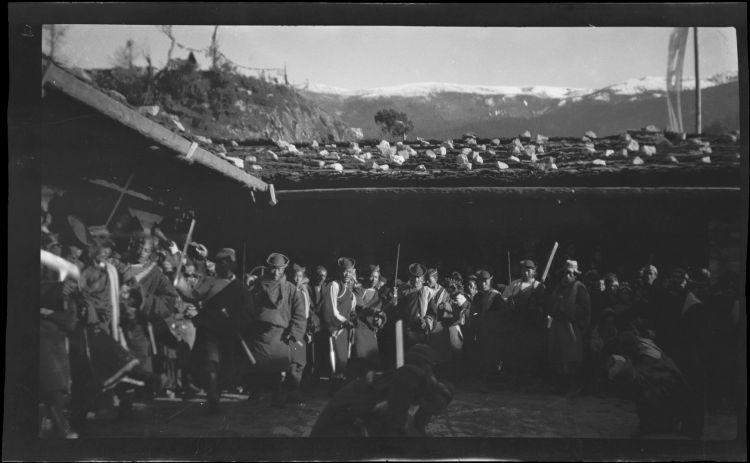
Title and statement of responsibility area
Title proper
Monks [at] Chumbie
General material designation
- Graphic material
Parallel title
Other title information
Title statements of responsibility
Title notes
- Source of title proper: Title based on the caption in photograph album.
Level of description
Item
Reference code
Edition statement
Edition statement of responsibility
Statement of scale (cartographic)
Statement of projection (cartographic)
Statement of coordinates (cartographic)
Statement of scale (architectural)
Issuing jurisdiction and denomination (philatelic)
Dates of creation area
Date(s)
Physical description area
Physical description
1 photograph : b&w negative ; 9 x 15 cm
Publisher's series area
Title proper of publisher's series
Parallel titles of publisher's series
Other title information of publisher's series
Statement of responsibility relating to publisher's series
Numbering within publisher's series
Note on publisher's series
Archival description area
Name of creator
Biographical history
Lieutenant Colonel Eric Parker was born on June 16, 1896, in London, England. He was a British military Commander with the Indian government who led a little known expedition of approximately 200 Punjabi soldiers from Calcutta to Tibet in November 1921. In addition, Lt. Col. Parker conducted basic and advanced infantry training of Tibetan soldiers from January to March 1923 at the request of the Tibetan military. During his military career, Lt. Col. Parker corresponded with British diplomat, Sir Charles Bell, and various members of the Tibetan government, including the 13th Dalai Lama.
On January 2, 1923, Lt. Col Parker married in Calcutta and, with his wife, travelled back to Tibet on horseback where his training of Tibetan soldiers would begin. After his initial British disapproval, Lt. Col. Parker became accepting of the Tibetan culture and during this period of his life learned to speak in Tibetan, Urdu, Tamil, and Punjabi. The Parkers adapted to Tibet, living in both Yutang and Ganze. After Lt. Col. Parker was released from the military, the couple tried to stay on and establish a trading station, but lasted only one year. During their stay in Tibet the Parkers collected numerous objects, letters, and photographs that provide rare documentation of this period in Tibet’s history (i.e., before the Chinese invasion in 1950). Lt. Col. Parker died in 1988.
Lt. Col. Parker was in the Indian military at a significant time in Tibetan history. From 1918-1921, evidence suggests the Dalai Lama continued to forge closer ties to the British. Since the Simla Convention in 1914, Britain and Tibet had agreed to Chinese ‘suzerainty’ over Tibet, but China refused to ratify the pact and agree to the territorial divisions established. In 1918, fighting broke out between British-trained Tibetan troops and the Chinese, and was later followed by British attempts to mediate and discuss a Tibetan autonomy settlement. In 1920 to 1921, Sir Charles Bell went to Lhasa to urge better relations between Tibet and Britain. Despite Tibetan reluctance to accept further British influence, Charles Bell suggested increasing military aid to Tibet, and it was in 1923 that Lt. Col. Parker arrived to train the soldiers. In 1924-25, pressure from the monks caused the Dalai Lama to dismiss his British-trained officers. Tibetan independence lasted until the overthrow of the Republic of China by the Communists in 1949, and the establishment of the People's Republic of China.
In 2005, photographs and textual records, along with several objects, were donated to the Museum of Anthropology by Lt. Col. Parker’s daughter, Mrs. Mary Noble. Lt. Col. Parker’s grandson, Father Harry Donald, provided valuable contextual information and is currently preparing to write a history of his grandfather’s time in Tibet.
Custodial history
Scope and content
Item is a negative showing a group of Tibet soldiers standing in front of a stone wall.
Notes area
Physical condition
Immediate source of acquisition
Arrangement
Language of material
Script of material
Location of originals
Availability of other formats
Photograph is available in print form in album A.
